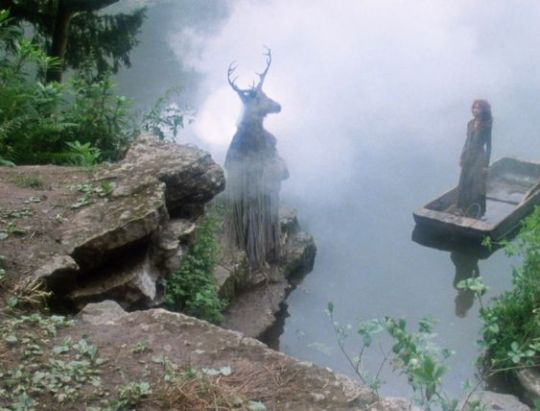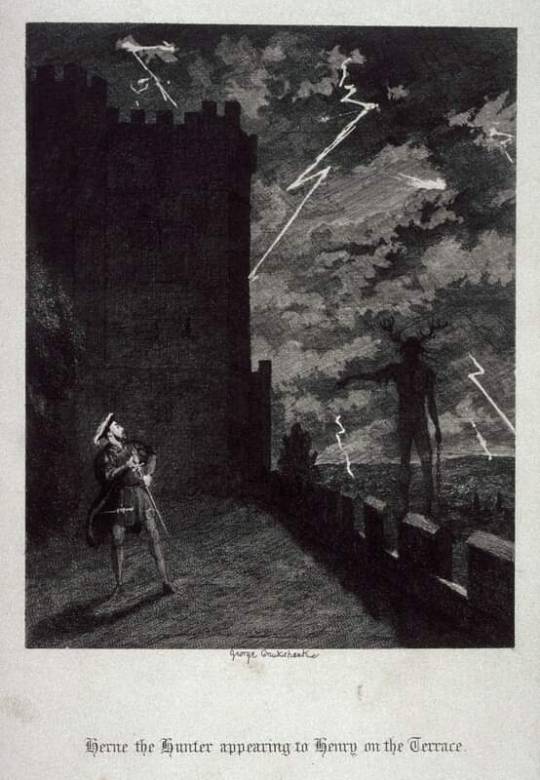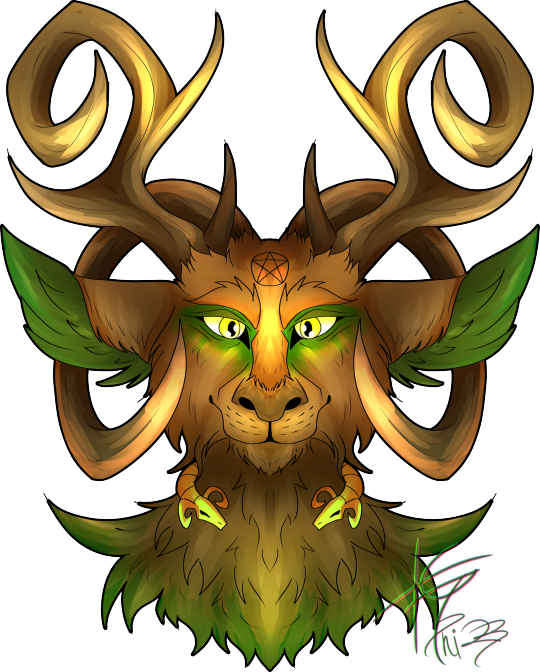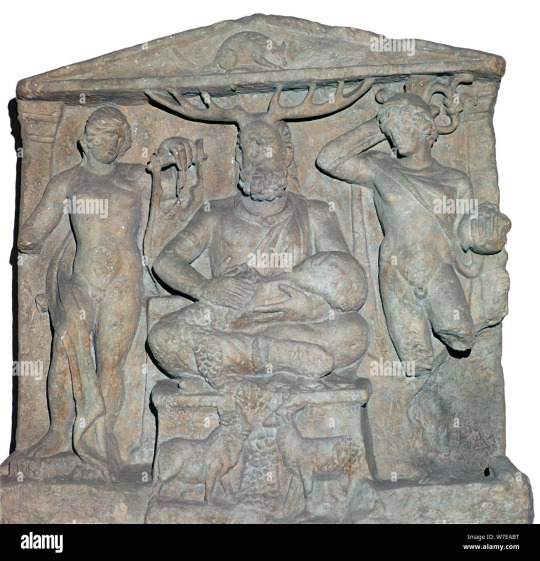#herne the hunter
Explore tagged Tumblr posts
Text

'Herne the Hunter' English folklore ghost who haunts Windsor with his hounds and an owl by George Cruikshank, 1843.
782 notes
·
View notes
Text

Keith Robinson, for the Robin of Sherwood Annual 1987.
129 notes
·
View notes
Text

This winter solstice, the darkest day of the year, I wish you all peace, love and hope. As the days grow brighter, so may our troubled world. * Also, a heartfelt thank you to everyone who cheered me on through a year of personal struggle with likes and shares and encouraging comments. Your support for my art means the world to me ❤️ I didn’t have time to make a new and more appropriate card to go with this more-serious-than-normal message, so we’ll have to make do with season’s greetings from thirst trap Santa *ahem* I mean pagan fertility god. Hope he brings you a smile 🎅🏻❄️ (Somebody find him a sweater, it’s chilly out)
239 notes
·
View notes
Text

Robin of Sherwood - The Enchantment. Herne and Marian.
568 notes
·
View notes
Text

Herne the Hunter appearing to Henry VIII on the terrace, by George Cruickshank for William Ainsworth's "Windsor Castle" (1843)
25 notes
·
View notes
Text

herne the hunter - some work from my current uni project! i’ve been in and out of hospital for a few months and being able to draw again has felt so good :-) looking forward to having more time for personal work too!
#art#digital art#fantasy#folklore#herne the hunter#british folklore#wild hunt#artists on tumblr#uni work
25 notes
·
View notes
Text
The Oak and the Holly King, and their solstice showdown.
(Scroll down for the story)

The oak and holly king
The story of the Oak and Holly Kings is deeply rooted in ancient folklore, particularly within Celtic and Druidic traditions, although it’s important to note that the specific narrative as we know it today—of these two kings battling for dominion over the seasons—has been shaped and revived in more recent times by modern Pagan and Wiccan traditions. However, the roots of the story stretch far back to pre-Christian beliefs about the cycles of nature, the power of the solstices, and the worship of sacred trees.
Ancient Connections to Sacred Trees
The concept of sacred trees, particularly the oak, is central to many ancient traditions. The oak was highly revered by the Celts, who saw it as the King of the Forest. It symbolized strength, endurance, and the masculine principle. The oak’s deep roots in the earth and its towering presence in the forest made it a symbol of vitality and life, particularly associated with the sun and the summer months.
The holly, by contrast, had a more mystical and protective role. Its evergreen leaves and bright red berries made it stand out during the harsh winter months, when much of the landscape lay dormant. The Celts associated the holly with winter and the darker months, seeing it as a symbol of protection, fertility, and resilience. In Druidic lore, the holly tree was often seen as a guardian spirit of the underworld, which connects it to the realm of death and renewal.
These two trees represent opposites in the cycle of life—life and death, light and dark, and growth and decay—which is why they became symbolic of the eternal rhythm of the seasons.
The Battle of the Oak and Holly Kings in Celtic Mythology
The story of the Oak and Holly Kings doesn’t appear verbatim in ancient Celtic texts, but the thematic elements are strongly aligned with Celtic beliefs in seasonal cycles and the interplay between the forces of light and dark. The Celts understood time as cyclical, with the changing of the seasons seen as a battle between opposing forces. This is most evident in their mythologies, which often feature gods and goddesses who personified the seasons or the solar cycles.
While the Oak King is not a figure explicitly named in ancient Celtic myths, his association with the summer solstice and the sun aligns closely with deities like the Green Man, the Horned God, or the Sun God, such as Lugh or Belenus, who were central to Celtic religion and worshipped at the height of summer. The Oak King represents the rising power of the sun, growing in strength as the days lengthen.
The Holly King, on the other hand, is a figure whose influence is less direct in ancient mythology but who fits well within the framework of the Winter Solstice—a time when the light retreats and the darkness reigns. His connection with holly, a plant that thrives in winter, also connects him with ancient symbols of death, rebirth, and the protective, purifying powers of the dark. He can be seen as analogous to the Celtic figures of the Dark God or the Horned God in his aspect of winter, death, and renewal. The idea of a ruler of the dark half of the year is reflected in the figure of Cailleach, the Celtic winter goddess who reigns over the harsh cold months.
The Solstices as Turning Points
The idea of a battle for dominance between the Oak and Holly Kings aligns with the Winter Solstice and Summer Solstice, key turning points in the year when the sun is either at its lowest or highest point in the sky. The Solstices were of great importance to the Celts and other ancient peoples, as they marked the changing of the seasons and the movement between light and dark.
At the Winter Solstice, the Holly King’s reign over the dark half of the year reaches its peak, but as the Oak King slowly begins to take over, the days lengthen, and the sun begins its return. The reverse happens at the Summer Solstice, when the Oak King’s reign begins to wane, and the Holly King rises to claim dominion over the dark months again.
The Modern Revival
The modern retelling of the Oak and Holly Kings battle comes from a blending of old Celtic traditions with newer Pagan and Wiccan beliefs, particularly in the 20th century. Figures like Gerald Gardner, one of the founders of modern Wicca, and later Pagan writers like Doreen Valiente and Starhawk, helped to shape and popularize the idea of the Oak and Holly Kings as two mythical figures representing the seasonal battle between light and dark.
These contemporary adaptations often draw on the traditional symbolism of these trees, the changing seasons, and the Solstices, but the exact story as we know it today is largely a modern creation, inspired by the themes present in ancient Celtic myth, and perhaps even influenced by folklore surrounding the Green Man and the Cailleach, two figures whose stories embody similar cyclical changes in the natural world.
Summary: An Archetypal Tale of Balance
The Battle of the Oak and Holly Kings is less about a specific historical or mythological origin and more about a universal archetype: the dance of light and dark, life and death, summer and winter. It’s a story that, although not fully documented in ancient myths, resonates with ancient practices and beliefs tied to the natural world. It serves as a reminder that all things are in constant flux, and the forces of light and dark are not in opposition, but in balance—a relationship that sustains the very cycle of life.
So, while the Oak and Holly Kings may not have been named explicitly in ancient Celtic myth, the themes of their battle—of shifting power, of cyclical renewal, of the eternal dance between light and dark—are deeply embedded in the seasonal rhythms of the earth, making their story one that continues to inspire and resonate today.
Conclusion: The Blessing of the Oak and Holly Kings
As the Wheel of the Year turns once more, the Winter Solstice marks a sacred transition—when darkness reaches its peak and light begins its slow, steady return. The Oak King and the Holly King, locked in their eternal dance, remind us of the beautiful balance within all things: light and shadow, growth and rest, life and death. The Holly King, ruler of the waning year, gently steps aside, honouring his role in holding space for introspection, endurance, and the lessons of the dark. The Oak King, vibrant with potential, rises to bring light and renewal, promising growth and the slow awakening of the earth.
This ancient story is not just a tale of two kings—it’s a reflection of the cycles we all live through. In our own lives, there are moments to honour the Holly King within us, letting go, retreating, and seeking wisdom in stillness. And there are moments to welcome the Oak King, embracing light, action, and the promise of new beginnings. Together, they remind us that every end carries the seed of a beginning, and every winter holds the quiet promise of spring.
A Blessing for the Oak and Holly Kings
To the Holly King, Keeper of the Dark:
May your rest be peaceful, your wisdom honoured,
And your gift of stillness held in gratitude.
You who guard the night and protect the soul’s journey,
We thank you for your strength and patience.
May we carry your lessons of endurance and grace as we move forward.
To the Oak King, Bringer of the Light:
May your reign be bright, your energy abundant,
And your gift of renewal inspire growth within us.
You who awaken the earth and kindle the fires of hope,
We welcome your return with open hearts.
May we walk boldly into the light you bring,
Guided by courage, wisdom, and joy.
And to the Dance of the Year that unites them both:
Blessed be the turning of the Wheel,
Blessed be the balance of dark and light,
Blessed be the cycle of life everlasting.
So it is, and so it shall be.
Follow Tbe Lantern’s
Glow
#yuletide#yule#winter solstice#paganism#modern paganism#storytime#the wheel of the year#folklore#witchcraft#eclectic wicca#Spotify#cernunnos#herne the hunter#the green man#wildwood
7 notes
·
View notes
Text

Not necessarily finished but finished enough for now.
I had a lovely Christmas break which included rewatching BBC4s reshowing of The Box of Delights, and seeking to prolong festive vibes I started work on a cover type image…
As we moved into January I graduated from festive mode into spy media mode and watched all of Slow Horses and rewatched Tinker Tailor while working on this. Bet John Masefield could’ve written a good spy novel.
4 notes
·
View notes
Text

Phantoms of the Forest featuring Herne the Hunter from Spellbound No. 61, 19 November 1977. DC Thomson.
30 notes
·
View notes
Text

George Cruikshank, Herne the Hunter appearing to Henry on the terrace; 1843
#george cruikshank#herne the hunter#art#artwork#dark art#dark artwork#esoteric#esoteric art#esoteric artwork
33 notes
·
View notes
Text
29th January
Herne the Hunter

Source: Herne the Hunter on Craiyon
On this day in 1906, the ancient tree, Herne’s Oak was replanted in Windsor Park, Berkshire. According to legend, Herne was a skilled hunter who saved the life of King Henry VIII by placing himself between the monarch and a charging stag. Herne was made Henry’s chief huntsman as a reward, but jealous gossip ultimately led to the hero’s dismissal from the king’s service. A distraught Herne then killed himself. But his story did not end there. In death, Herne transformed in a giant stag-masked hunting god, and has haunted the woods of Windsor Park ever since, leading phantom hounds in a never-ending pursuit of spectral stags. Herne was believed to be real enough, appearing in Shakespeare’s Merry Wives of Windsor to terrify a drink-addled Falstaff. The unwary are advised to flee at the sight of Herne, whose bow has been known to seek human victims as well as the creatures of the forest.
Herne is almost certainly a Tudor memory of the Celtic god of the Underworld, the winter deity, stag-headed Cernunnos. The god’s manifestation, like that of Herne, is best avoided by mortals.
5 notes
·
View notes
Text
Holding my heart,
in your hand,
Horned head raised high,
proud and pristine.
O’ Herne,
Hunter of the Hills,
you protect my presence,
make home for my heart,
and guide my judgment.
For it is you
who roams the land
and doing so
holds my hand.
11 notes
·
View notes
Text
why is my newest hyper fixation cernunnos and the wild hunt?? who knows. am I writing I planning out a 70k tomarry fanfic with celtic mythology because of it?? yes.
3 notes
·
View notes
Photo

Hail to the Horned One! The Stag of the Green Wood Grove! The Goat of the Dark Forest! God of the Fertile Earth! I Hail To You! Cernunnos, Pan, Herne! Hail to you, Ol’ Hornie! Hail to you, god of a thousand names!
9 notes
·
View notes
Text
Lore | Horned God
[This one is a little longer]
Horned God may in fact be the horned GODDESS [hypothetically]
[Deer Goddess]
The Horned gods origins are a little tricky. There are sources that claim that the Horned god was originally the horned goddess. Cernunnos, originally derived from old pagan myths of a horned ‘Goddess’ , a story about how a deer would turn into a woman. In folklore society in 1930, a researcher put his theories on a matriarchal Hunter gatherer society ruling highlands of scotland as a pre-celtic deer cult. J.G. Mckay.
Modern Scottish Gaelic and modern Irish Gaelic dictionaries both give the word Fiadh having two meanings: “Deer,” “God.” The deer was some sort of god, as well as divine messenger, some type to the Goddess Artemis. How you had to ask permission to hunt.
In Faerie lore, deer are their cattle and a common form of Faire women, Witches can transform into mice, hares, cats or black sheep but never the sacred deer.
In many pagan animal-cults, the priest or priestess would often wear an ornamental headdress of the sacred animal. There are Scottish folktales of a deer woman that Mckay theories could be explained by this real practice. In these folktales, a hunter, who has been stalking deer, observes, when putting up his gun to take aim, that the animal changed into a woman. He falls in love with her. Adventures ensue and they are separated until he finds her again on a distant island and they finally marry and live happily ever after.
The Deer Cult and the deer-goddess cult date back from a remote matriarchal time. Diana as well as Artemis and her nymphs, would appear to be classical examples of a hint at this older heritage. No one in patripotestal times, it would seem, would dream of inventing a feminine hunting divinity.

Celtic Society developed and created a masculine Horned God from the deer goddess and keep the feminine character next to him as a reminder as his shadow. By the stage the Deer Goddess matriarchy would have been in decay and her worshippers have grown fewer. While worshippers of the male Cernunnos became ever more numerous.
Today, there are whispers of this old Deer Goddess Cult in traditional German and English stag dances that are performed by men who dress themselves in women’s clothes, thereby preserving a memory of a former time when stag-dances were perfect by women, and of a later time, when the religious functions of women were usurped by men.
Shakspearen roots.
Swiftly moving on a couple thousand years, we come to the iconic bard, Shakespeare. Elizabethan english comedy abounds with images of the cuckold- a man with horns on his head, symbolising his shame that his wife has taken up with another man-
Herne the Hunter- from Shakespeare to popular culture. So at least thats where the name came from.
Robin Hood Myth [Horned God]
[Authors note: This website is not secured so take care also- these types of websites were the ones I’ve seen and how I came to know about Wicca]
The Horned God is the father of Robin Hood? And it’s Pagan?
The Horned god is a central theme/character in many european pagan faiths. Generally seen as a deity of woods, wild animals, hunting and virility he is an elemental force of nature and commonly identified as a male deity often the consort of the female force or earth mother.
This is the case in the Wicca religion where the horned god is worshipped as both the child and the consort of the great Mother, Triple Goddess.
There are some evidence that the idea of the ‘Lord’ and ‘Lady’ in Wicca is part of ancient tribal rites but such evidence is limited.
For many modern Wiccans the ‘Horned God’ sometimes known as the Great God or Great Father is his own father.
Mating with the Goddess at Beltaine then dying at Summer Solstice only to be reborn as her child at the new year, or Winter Solstice, he is a key symbol in the birth/death/Rebirth cycle.
The Horned God is known as the ‘Hunter’ has strong links in Britain with the idea of ‘Wild Hunt’ he is the taker of life, a vengeful spirit, hunting evil with a pack of demonic hounds.
He is often portrayed as carrying a bow.
The british Herne the HUnter is rumoured to survive still as a powerful spirit.
Herne is linked to Robin Hood just as Robin provided for the needy, Herne provided food for the tribe.
In some legends he is listed as Robin Hoods father, although this adds greater status to Robin Hoods legends.
He is portrayed has either having horns or Antlers, as well as his image is full of Phallic symbols.
Locations: There have been representations of Fertility icons for thousands of years as in the Altars of Stag Horns which have been found in Temples of Apollo and Diana in ancient Greece.
He is sometimes depicted with hooves or Goat hindquarters, a link to the Greek God Pan. Which of course had christians mistaken this horned fello for Satan.
Stag God image can be found in a cave painting at Trosi-Freres in France. This painting is thought to date around 13,000 BC known as the “Sorcerer” and depicts a half human, half stag spirit. This image is often seen as a representation of a shaman dressed as a stag performing a rite to ensure good hunting.

The Horned God is not an exclusively Wiccan concept as one would expect as many Pagan faiths have similar roots, the Horned god concept can be seen in the Greek God Pan, the Celtic god of the underworld and animals cernunnos, the Roman Janys, Tammuz and Damuzi the consorts of Ishtar and Inanna, Osiris and Dionysus as well as the Green Man mythological figure in the Uk.
The link with Osiris and Cernunnos which were both gods which guarded the underworld or judged souls and Osiris was both brother and consort of Isis seen by many as the Egyptian mother goddess. Cernunnos was a fertility god of the pagan celts and Gauls and is thought by many to have been the basis for the christian concept of the horned devil being a half man half goat guardian of the underworld and certainly a rival faith for early christianity.
The link between the Horned God and the Green man in English folk lore is very strong and even today many pubs in UK villages bare the name “The Green Man” often with a very pagan image on the pub sign. The Green man also known as ‘Green Jack’ or ‘Jack in the Green’ is an English spirit of trees and plants with the power to make it rain and crops grow well. The Green man is thought to share his home in the forest with forest fairies sometimes called “Greencoates” or Greenies depending on the region of the UK. In popular imagery the Green man is shown as face peering out of foliage, his wood spirit companions and fertility imagery clearly links him to Pan and also as a sort of sanitised Hern the Hunter and Wild hunter.
For many modern Druids and Wicca the Horned god is a key part of the birth, death, rebirth cycle and mentioned in many rites and celebrations, his imagery is powerful and has a strong attraction to many as a symbol of almost suppressed power / violence and male sexuality. Some modern pagans reenact the ancient rite where the hunter who brought the most/ best meat to the table was dressed in stag horns and furs and was rewarded with the right to couple with the priestess representing the goddess sometimes in front of the whole tribe. The few pagan groups that reenact this mostly do so symbolically or with the hunter and goddess being intimate partners already with only a small part of this “Great Rite” being performed before the rest of the coven.
#horned#god#horned god#LORE#witch#witchtok#witch community#witchcraft#witchblr#wiccan#pagan#wicca#Pan#belief#wiccan religion#baby witch#baby#Herne the Hunter#herne#the#hunter
3 notes
·
View notes
Link
Chapters: 1/1
Fandom: Robin of Sherwood (TV 1984)
Rating: Teen and Up Audiences
Warning: Major Character Death
Relationships: Robert of Huntingdon & Marion of Leaford, Robert of Huntingdon & Will Scarlet, Robert of Huntingdon & Friar Tuck, Robert of Huntingdon & Merry Men, Robert of Huntingdon & Herne the Hunter
Characters: Robert of Huntingdon, Marion of Leaford, Will Scarlet, Friar Tuck, Little John, Much the Miller’s Son, Nasir (Robin of Sherwood), Herne the Hunter, Robin of Loxley (mentioned)
Additional Tags: Alternate Universe - Canon Divergence, 2x07/3x01 rewrite, Robert doesn’t reject the call, And accepts his destiny as Herne’s son, Introspection, Grief/Mourning, Developing Friendships, (though there’s still a way to go), Some of the Merries don’t really talk to him hence why they’re only in the character tags, No one actually dies in this fic but Robin’s death is mentioned so I’m just being cautious, Robert is also more aware of his privilege than in canon
Summary: Eighteen-year-old Robert of Huntingdon, despite his intial reservations, decides he'll remain and become Herne's son - but still worries about the reaction of the Merries, and whether he can truly take on the mantle.
2 notes
·
View notes